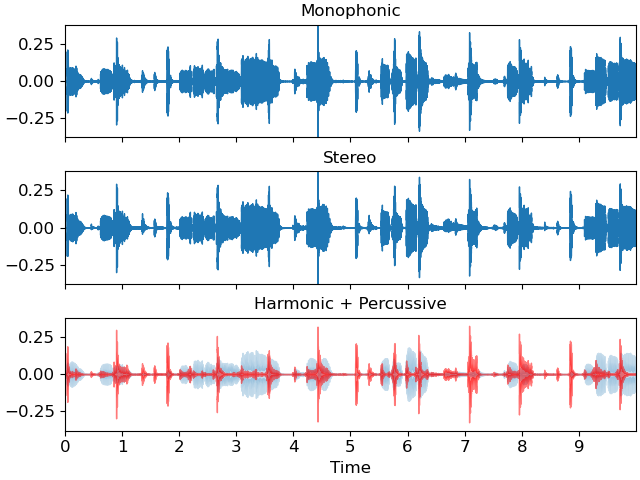Caution
You're reading an old version of this documentation. If you want up-to-date information, please have a look at 0.10.2.
librosa.display.waveplot
- librosa.display.waveplot(y, sr=22050, max_points=50000.0, x_axis='time', offset=0.0, max_sr=1000, ax=None, **kwargs)[source]
Plot the amplitude envelope of a waveform.
If
yis monophonic, a filled curve is drawn between[-abs(y), abs(y)].If
yis stereo, the curve is drawn between[-abs(y[1]), abs(y[0])], so that the left and right channels are drawn above and below the axis, respectively.Long signals (
duration >= max_points) are down-sampled to at mostmax_srbefore plotting.Warning
This function is deprecated in librosa 0.8.1 and will be removed in 0.9.0. Its functionality is replaced and extended by
waveshow.- Parameters:
- ynp.ndarray [shape=(n,) or (2,n)]
audio time series (mono or stereo)
- srnumber > 0 [scalar]
sampling rate of
y- max_pointspostive number or None
Maximum number of time-points to plot: if
max_pointsexceeds the duration ofy, thenyis downsampled.If None, no downsampling is performed.
- x_axisstr or None
Display of the x-axis ticks and tick markers. Accepted values are:
- ‘time’markers are shown as milliseconds, seconds, minutes, or hours.
Values are plotted in units of seconds.
‘s’ : markers are shown as seconds.
‘ms’ : markers are shown as milliseconds.
‘lag’ : like time, but past the halfway point counts as negative values.
‘lag_s’ : same as lag, but in seconds.
‘lag_ms’ : same as lag, but in milliseconds.
None, ‘none’, or ‘off’: ticks and tick markers are hidden.
- axmatplotlib.axes.Axes or None
Axes to plot on instead of the default plt.gca().
- offsetfloat
Horizontal offset (in seconds) to start the waveform plot
- max_srnumber > 0 [scalar]
Maximum sampling rate for the visualization
- kwargs
Additional keyword arguments to
matplotlib.pyplot.fill_between
- Returns:
- pcmatplotlib.collections.PolyCollection
The PolyCollection created by fill_between.
Examples
Plot a monophonic waveform
>>> import matplotlib.pyplot as plt >>> y, sr = librosa.load(librosa.ex('choice'), duration=10) >>> fig, ax = plt.subplots(nrows=3, sharex=True, sharey=True) >>> librosa.display.waveplot(y, sr=sr, ax=ax[0]) >>> ax[0].set(title='Monophonic') >>> ax[0].label_outer()
Or a stereo waveform
>>> y, sr = librosa.load(librosa.ex('choice', hq=True), mono=False, duration=10) >>> librosa.display.waveplot(y, sr=sr, ax=ax[1]) >>> ax[1].set(title='Stereo') >>> ax[1].label_outer()
Or harmonic and percussive components with transparency
>>> y, sr = librosa.load(librosa.ex('choice'), duration=10) >>> y_harm, y_perc = librosa.effects.hpss(y) >>> librosa.display.waveplot(y_harm, sr=sr, alpha=0.25, ax=ax[2]) >>> librosa.display.waveplot(y_perc, sr=sr, color='r', alpha=0.5, ax=ax[2]) >>> ax[2].set(title='Harmonic + Percussive')
